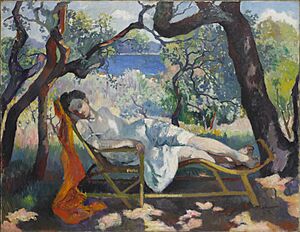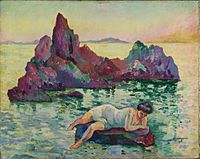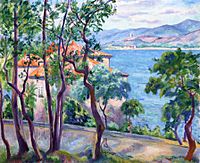Henri Manguin facts for kids
Quick facts for kids
Henri-Charles Manguin
|
|
|---|---|

Henri and Jeanne Manguin, 1900
|
|
| Born | 23 March 1874 Paris, France
|
| Died | 25 September 1949 (aged 75) Saint-Tropez, France
|
| Known for | Painter |
| Movement | Post-Impressionism, Fauvism |
Henri Charles Manguin (born March 23, 1874 – died September 25, 1949) was a French painter. He is known for being part of a group of artists called the Fauves.
Manguin studied art at the École des Beaux-Arts in Paris. His teacher was Gustave Moreau. He became good friends with other students like Henri Matisse and Charles Camoin. Like them, Manguin copied famous Renaissance artworks at the Louvre museum.
Manguin was very inspired by Impressionism. You can see this in his paintings, which often use bright, soft colors called pastel hues.
He got married in 1899 to Jeanne. He painted many pictures of his wife and their family. In 1902, Manguin showed his art for the first time. This was at the Salon des Indépendants and Salon d'Automne exhibitions. Many of his paintings showed beautiful Mediterranean landscapes. These works helped him become a well-known Fauve artist.
Contents
The Rise of Fauvism in 1905
In 1905, a new art style called Fauvism started to become very popular. This happened at the Salon des Indépendants exhibition, which ran from March to April. Later that year, the famous Salon d'Automne exhibition truly marked the beginning of Fauvism.
A critic named Louis Vauxcelles saw their art. He described the paintings as "wild beasts" (fauves in French). He said this because the paintings were so different from a traditional sculpture in the same room. This is how the term "Fauvism" was born.
Artists at the 1905 Exhibition
At the 1905 Indépendants exhibition, Manguin showed his art alongside many other important painters. These included Henri Matisse, Albert Marquet, Jean Puy, André Derain, and Maurice de Vlaminck.
Matisse was in charge of arranging the artworks for the exhibition. Manguin helped him with this important task.
Later Years and Legacy
After 1920, Manguin continued to exhibit his work. He showed paintings at the Gallery Marcel Bernheim. He also traveled a lot with his friend and fellow artist, Albert Marquet. They explored many places in Southern Europe together.
In 1949, Manguin left Paris and moved to Saint-Tropez. He passed away there shortly after, on September 25, 1949. His colorful paintings continue to be admired today.
Gallery of paintings
See also
 In Spanish: Henri Manguin para niños
In Spanish: Henri Manguin para niños





